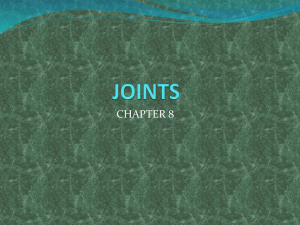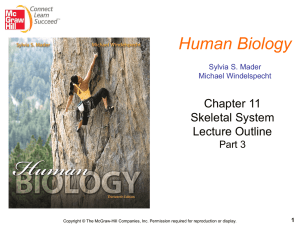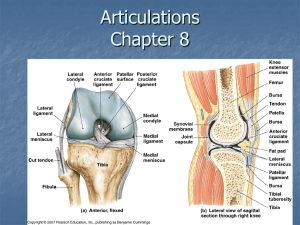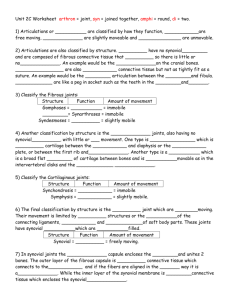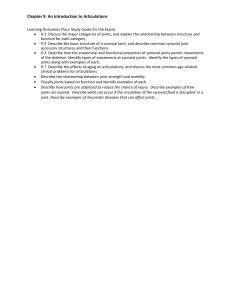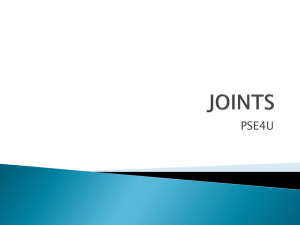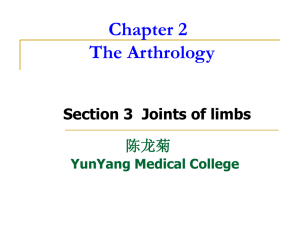Chapter 8 Joints Classification of Joints Fibrous Joints
advertisement
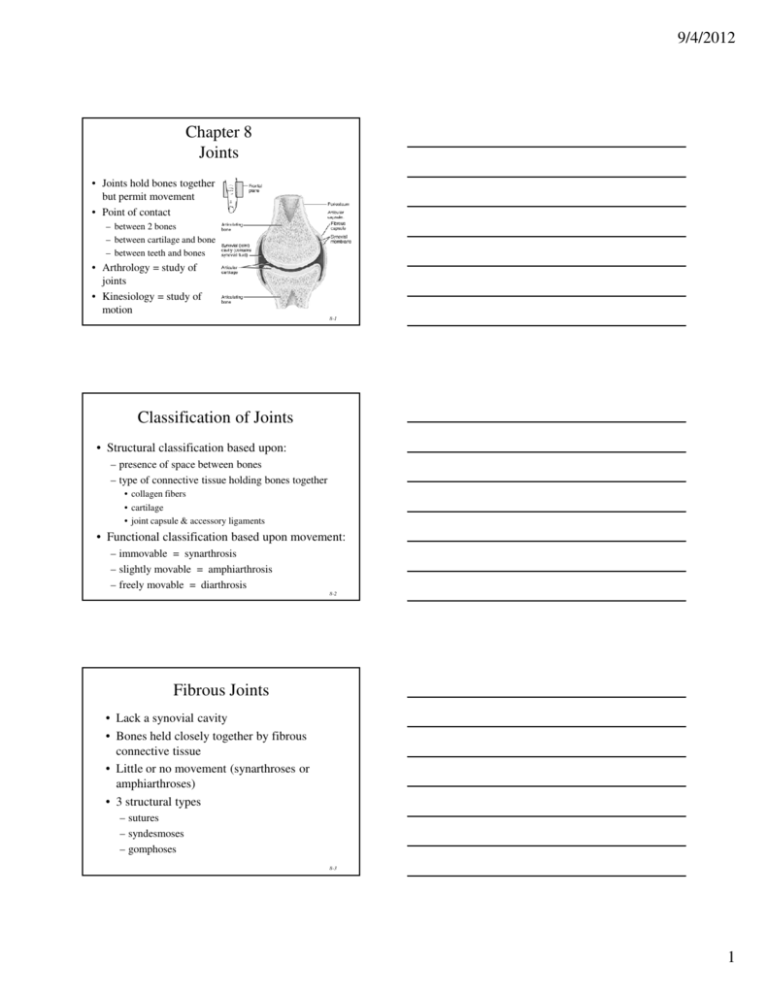
9/4/2012 Chapter 8 Joints • Joints hold bones together but permit movement • Point of contact – between 2 bones – between cartilage and bone – between teeth and bones • Arthrology = study of joints • Kinesiology = study of motion 8-1 Classification of Joints • Structural classification based upon: – presence of space between bones – type of connective tissue holding bones together • collagen fibers • cartilage • joint capsule & accessory ligaments • Functional classification based upon movement: – immovable = synarthrosis – slightly movable = amphiarthrosis – freely movable = diarthrosis 8-2 Fibrous Joints • Lack a synovial cavity • Bones held closely together by fibrous connective tissue • Little or no movement (synarthroses or amphiarthroses) • 3 structural types – sutures – syndesmoses – gomphoses 8-3 1 9/4/2012 Sutures • Thin layer of dense fibrous connective tissue unites bones of the skull • Immovable (synarthrosis) • If fuse completely in adults is synostosis 8-4 Articulations 1 5 Syndesmosis • Fibrous joint – bones united by ligament • Slightly movable (amphiarthrosis) • Anterior tibiofibular joint and Interosseous membrane 8-6 2 9/4/2012 Articulations 1 7 Gomphosis • Ligament holds cone-shaped peg in bony socket • Immovable (amphiarthrosis) • Teeth in alveolar processes 8-8 Articulations 1 9 3 9/4/2012 Cartilaginous Joints • Lacks a synovial cavity • Allows little or no movement • Bones tightly connected by fibrocartilage or hyaline cartilage • 2 types – synchondroses – symphyses 8-10 Synchondrosis • Connecting material is hyaline cartilage • Immovable (synarthrosis) • Epiphyseal plate or joints between ribs and sternum 8-11 Articulations 1 12 4 9/4/2012 Symphysis • Fibrocartilage is connecting material • Slightly movable (amphiarthroses) • Intervertebral discs and pubic symphysis 8-13 Articulations 1 14 Articulations 1 15 5 9/4/2012 Articulations 1 16 Synovial Joints • Synovial cavity separates articulating bones • Freely moveable (diarthroses) • Articular cartilage – reduces friction – absorbs shock • Articular capsule – surrounds joint – thickenings in fibrous capsule called ligaments • Synovial membrane – inner lining of capsule – secretes synovial fluid containing hyaluronic acid (slippery) – brings nutrients to articular cartilage 8-17 Example of Synovial Joint • Joint space is synovial joint cavity • Articular cartilage covering ends of bones • Articular capsule 8-18 6 9/4/2012 Other Special Features • Accessory ligaments – extracapsular ligaments • outside joint capsule – intracapsular ligaments • within capsule • Articular discs or menisci – attached around edges to capsule – allow 2 bones of different shape to fit tightly – increase stability of knee - torn cartilage • Bursae = saclike structures between structures – skin/bone or tendon/bone or ligament/bone 8-19 Arthroscopy & Arthroplasty • Arthroscopy = examination of joint – instrument size of pencil – remove torn knee cartilages & repair ligaments – small incision only • Arthroplasty = replacement of joints – total hip replaces acetabulum & head of femur – plastic socket & metal head – knee replacement common 8-20 Nerve and Blood Supply • Nerves to joints are branches of nerves to nearby muscles • Joint capsule and ligaments contain pain fibers and sensory receptors • Blood supply to the structures of a joint are branches from nearby structures – supply nutrients to all joint tissues except the articular cartilage which is supplied from the synovial fluid 8-21 7 9/4/2012 Sprain versus Strain • Sprain – twisting of joint that stretches or tears ligaments – no dislocation of the bones – may damage nearby blood vessels, muscles or tendons – swelling & hemorrhage from blood vessels – ankle is frequently sprained • Strain – less serious injury – overstretched or partially torn muscle 8-22 Planar Joint • Bone surfaces are flat or slightly curved • Side to side movement only • Rotation prevented by ligaments • Examples – intercarpal or intertarsal joints – sternoclavicular joint – vertebrocostal joints 8-23 Articulations 2 24 8 9/4/2012 Hinge Joint • Convex surface of one bones fits into concave surface of 2nd bone • Uniaxial like a door hinge • Examples – Knee, elbow, ankle, interphalangeal joints • Movements produced – flexion = decreasing the joint angle – extension = increasing the angle – hyperextension = opening the joint beyond the anatomical position 8-25 Articulations 2 26 Flexion, Extension & Hyperextension 8-27 9 9/4/2012 Pivot Joint • Rounded surface of bone articulates with ring formed by 2nd bone & ligament • Monoaxial since it allows only rotation around longitudinal axis • Examples – Proximal radioulnar joint • supination • pronation – Atlanto-axial joint • turning head side to side “no” 8-28 Articulations 2 29 Condyloid or Ellipsoidal Joint • Oval-shaped projection fits into oval depression • Biaxial = flex/extend or abduct/adduct is possible • Examples – wrist and metacarpophalangeal joints for digits 2 to 5 8-30 10 9/4/2012 Articulations 2 31 Abduction and Adduction Condyloid joints Ball and Socket joints 8-32 Saddle Joint • One bone saddled-shaped; other bone fits as a person would sitting in that saddle • Biaxial – Circumduction allows tip of thumb travel in circle – Opposition allows tip of thumb to touch tip of other fingers • Example – trapezium of carpus and metacarpal of the thumb 8-33 11 9/4/2012 Articulations 2 34 Ball and Socket Joint • Ball fitting into a cuplike depression • Multiaxial – flexion/extension – abduction/adduction – rotation • Examples – shoulder joint – hip joint 8-35 Articulations 2 36 12 9/4/2012 Articulations 2 37 Bursae and Tendon Sheaths • Bursae – fluid-filled saclike extensions of the joint capsule – reduce friction between moving structures • skin rubs over bone • tendon rubs over bone • Tendon sheaths – tubelike bursae that wrap around tendons at wrist and ankle where many tendons come together in a confined space • Bursitis – chronic inflammation of a bursa 8-38 Integumentary System - 39 CT 13 9/4/2012 Integumentary System - 40 CT Integumentary System - 41 CT Summary of Movements at Synovial Joints • Gliding – no change in angle of joint • Angular movements – increase or decrease in angle between articulating bones • flexion, extension, hyperextension • adduction, abduction • circumduction is a combination of above movements • Rotation – bone revolves around its own axis • Special movements – uniquely named movements for jaw, hand and foot 8-42 14 9/4/2012 Circumduction • Movement of a distal end of a body part in a circle • Combination of flexion, extension, adduction and abduction • Occurs at ball and socket, saddle and condyloid joints 8-43 Rotation • Bone revolves around its own longitudinal axis – medial rotation is turning of anterior surface in towards the midline – lateral rotation is turning of anterior surface away from the midline • At ball & socket and pivot type joints 8-44 Special Movements of Mandible • • • • Elevation = upward Depression = downward Protraction = forward Retraction = backward 8-45 15 9/4/2012 Special Hand & Foot Movements • • • • • • Inversion Eversion Dorsiflexion Plantarflexion Pronation Supination 8-46 Shoulder Joint • Head of humerus and glenoid cavity of scapula • Ball and socket • All types of movement 8-47 Glenohumeral (Shoulder) Joint • Articular capsule from glenoid cavity to anatomical neck • Glenoid labrum deepens socket • Many nearby bursa (subacromial) 8-48 16 9/4/2012 Supporting Structures at Shoulder • Associated ligaments strengthen joint capsule • Transverse humeral ligament holds biceps tendon in place 8-49 Rotator Cuff Muscles • Attach humerus to scapula • Encircle the joint supporting the capsule • Hold head of humerus in socket 8-50 Elbow Joint • Hinge joint – trochlea notch of ulna and trochlea of humerus – flexion and extension of elbow • Pivot joint – head of radius and capitulum of humerus – supination and pronation of forearm 8-51 17 9/4/2012 Articular Capsule of the Elbow Joint • Radial annular ligament hold head of radius in place • Collateral ligaments maintain integrity of joint 8-52 Hip Joint • Head of femur and acetabulum of hip bone • Ball and socket type of joint • All types of movement possible 8-53 Hip Joint Structures • Acetabular labrum • Ligament of the head of the femur • Articular capsule 8-54 18 9/4/2012 Articulations 2 55 Articulations 2 56 Hip Joint Capsule • Dense, strong capsule reinforced by ligaments – iliofemoral ligament – ischiofemoral ligament – pubofemoral ligament • One of strongest structures in the body 8-57 19 9/4/2012 Articulations 2 58 Articulations 2 59 Articulations 2 60 20 9/4/2012 Tibiofemoral Joint • Between femur, tibia and patella • Hinge joint between tibia and femur • Gliding joint between patella and femur • Flexion, extension, and slight rotation of tibia on femur when knee is flexed 8-61 Articulations 2 62 Tibiofemoral Joint • Articular capsule – mostly ligs & tendons • Lateral & medial menisci = articular discs • Many bursa • Vulnerable joint • Knee injuries damage ligaments & tendons since bones do not fit together well 8-63 21 9/4/2012 External Views of Knee Joint • Patella is part of joint capsule anteriorly • Rest of articular capsule is extracapsular ligaments – Fibular and tibial collateral ligaments 8-64 Intracapsular Structures of Knee • Medial meniscus – C-shaped fibrocartilage • Lateral meniscus – nearly circular • Posterior cruciate ligament • Anterior cruciate ligament 8-65 Temporomandibular Joint • • • • • Synovial joint Articular disc Gliding above disc Hinge below disc Movements – – – – depression elevation protraction retraction 8-66 22 9/4/2012 Atlanto-occipital joints • Atlas and occipital condyles • Condyloid Joint • Flexion • Extension • Slight lateral tilting 8-67 Intervertebral Joints • Between bodies and intervertebral discs – symphysis • Between vertebral articular processes – synovial • Flexion • Extension • Lateral flexion 8-68 Elbow Joint • Trochlea of humerus, trochlear notch of ulna & head of radius • Pivot and hinge types • Flexion, extension, pronation & supination 8-69 23 9/4/2012 Radiocarpal Joint • Articular disc • Condyloid type • Flexion, extension, abduction & adduction 8-70 Talocrural Joint • Tibia & fibula with talus • Hinge • Inversion, eversion, plantarflexion & dorsiflexion 8-71 Range of Motion in a Synovial Joint • • • • • Shape of articulating bones Tension & strength of joint ligaments Arrangement of muscles around joints Apposition (coming together) of soft parts Hormones – relaxin from placenta loosens pubic symphysis • Disuse – decreased synovial fluid, decreased flexibility of ligaments, reduced size of muscles 8-72 24 9/4/2012 Rheumatoid Arthritis • Autoimmune disorder • Cartilage attacked • Inflammation, swelling & pain • Final step is fusion of joint 8-73 Osteoarthritis • Degenerative joint disease – aging, wear & tear • Noninflammatory---no swelling – only cartilage is affected not synovial membrane • Deterioration of cartilage produces bone spurs – restrict movement • Pain upon awakening--disappears with movement 8-74 Gouty Arthritis • Urate crystals build up in joints---pain – waste product of DNA & RNA metabolism – builds up in blood – deposited in cartilage causing inflammation & swelling • Bones fuse • Middle-aged men with abnormal gene 8-75 25


